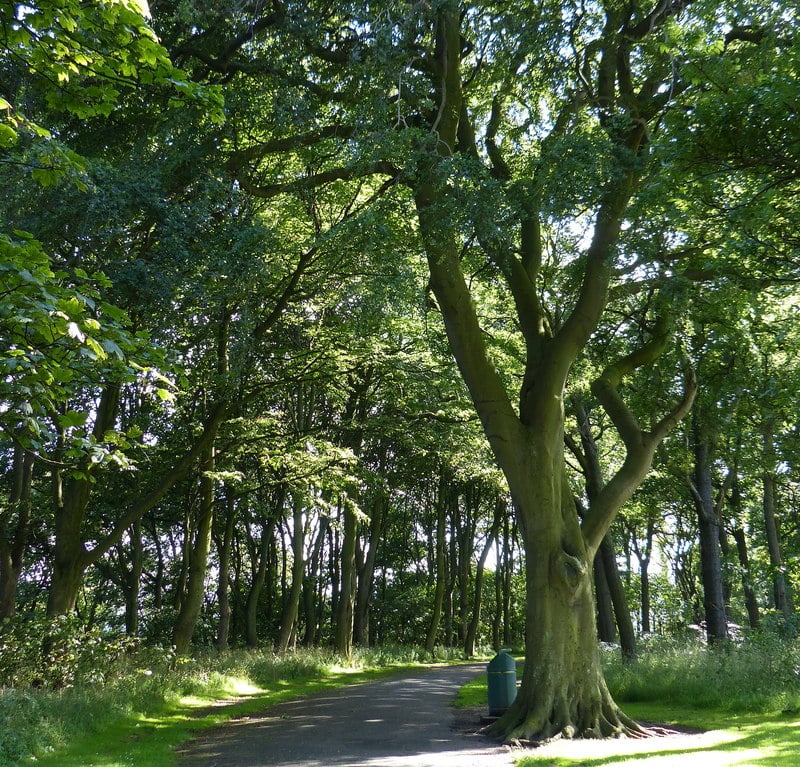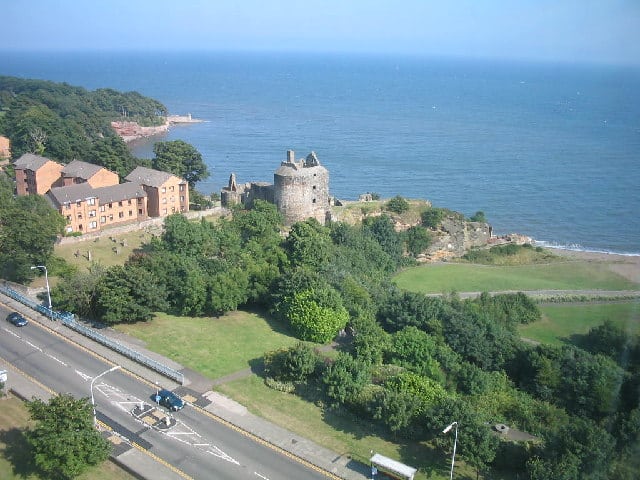Dating back as far as the late 1400s, the ruins of Ravenscraig Castle showcase one of the earliest artillery forts in Scotland. The prestigious castle sits a stone’s throw away from Edinburgh, making it easy to add to your list of things to do while sightseeing around Scotland. Come and learn about the intricate history of the notorious Sinclair family and see the castle ruins in the picturesque town of Kirkcaldy.
We’ll be covering the history of Ravenscraig Castle, how to get there & details to know, and the top attractions to see at Ravenscraig.
History of Ravenscraig Castle
Ravenscraig was built out of an act of love for Queen Mary of Gueldres, wife of King James II. Its construction was one of the first recorded, although it may have been the first, to resist cannon fire and stand as a powerful defence against artillery, thanks to its thick walls. What more could a Queen want from her castle?
Unfortunately, James II did not see the completion of Ravenscraig Castle and died during its construction at the Scottish Borders when a cannon exploded at the siege of Roxburgh Castle. Soon to follow, the widowed Queen followed her husband in 1463, only to see the east tower, west tower, and central vaults completed during her time. Mason Henry Merlion was the chief stoneworker who made the central block as resilient as it was.
The ownership of the castle passed to her son, James III. The new King granted the castle to the Sinclair family in exchange for the Earldom of Orkney and Kirkwall Castle
– which had been annexed from the Norse settlers there to the Scottish Crown. William Sinclair and his family completed Ravenscraig Castle and bolstered the castle’s defences with their interest in artillery fortifications.
The extravagant and well-built castle had many famous visitors throughout the 16th century, including James V and Mary of Guise. However, through this same century, Oliver Cromwell also attacked the castle, leaving the fortified homestead severely damaged. The castle remained under the Sinclairs, who had also built Dysart House nearby during this time.
Cut to the First World War, the castle was used as an ammunition depot throughout wartimes. Then, the castle and the surrounding grounds were given to the town of Kirkcaldy as a park, and the estate has been managed by Historic Environment Scotland ever since.
How to Get There & Details to Know
Ravenscraig Castle sits in Kirkcaldy within the bounds of Ravenscraig Park, precisely the western edge of the verdant park. Unfortunately, the castle ruins aren’t open to entry, but visitors can take stunning photographs from the park’s boundary instead.
The 15th-century castle doesn’t require any entry fees to see, and this limited access makes Ravenscraig a quick and easy stop while exploring Edinburgh and Perthshire.
How to Get There by Car
From Edinburgh, take the A90 westward until you reach the Queensferry Bridge. Head norther along the M90 until you reach the A92 towards Fife. Follow the offramp once you see the signs taking you to Kirkcaldy, and you’ll enter. Ravenscraig Castle can be found within Ravenscraig Park, as well as a car park.
How to Get There by Transit
Head to Edinburgh Waverly, catching the Aberdeen line from the station. This takes you to 3 stops to Kirkcaldy. From there, the castle is about a 10 -15 minute walk.
If you plan to go by bus instead, you can take the Princess Stop bus to Leven for 29 stops until it reaches Ravenscraig Park. This route should take you about an hour and a half to reach Ravenscraig Castle.
Attractions at Ravenscraig Castle
While visitors can’t step inside the towers of Ravenscraig Castle, there are still a number of unique attractions that you can enjoy while at this historic tower house.
Explore Ravenscraig Park

Ravenscraig Castle is a part of the beautiful Ravenscraig Park, which holds a number of attractions that any visitor to the park should absolutely make time to come and see.
Kirkcaldy Coastal Turret

The Kirkcaldy Coastal Turret likely was created by the Sinclair family as additional defences against potential attackers from the sea. The ruins of the turret have seen natural erosion over time, and the steps leading up to the turret can only be used during low tide – but it is accessible all the time from Ravenscraig Castle.
In addition to the castles within Kirkcaldy, take advantage of this hidden gem of a historic site.
Ravenscraig Park Beach

If you want to eat an on-the-go lunch with a view, take advantage of the opportunity to visit Ravenscraig Park Beach. The beach is only a few minutes walk from Ravenscraig Castle and features a stunning sea view with Edinburgh and the Lothians on the horizon.
It’s easy to imagine the Sinclair family walking along this beach during Scotland’s peaceful eras when they grew tired of the courtyard at the castle.
Add this romantic attraction within Ravenscraig Park if you want a picturesque Scottish beach to walk along – preferably with a snack or two.
Ravenscraig Walled Garden

Ravenscraig Walled Garden is a small, entrancing area of the park filled with lovely flowers and foliage to explore. The air is filled with the beautiful scents of roses, each offering a distinctly different smell than the last.
Ravenscraig Walled Garden is a quick attraction that you can fit into a day of sightseeing while visiting Kirkcaldy, so make sure to take advantage of your visit!
Take Pictures of Ravenscraig Castle

Although you can’t cross the rock-cut ditch bridge to explore the two D-plan towers of Ravenscraig Castle, there are plenty of opportunities to take stunning pictures. The castle holds a mysterious atmosphere unlike many of Scotland’s castles with historical roots as one of the first artillery defences throughout Scotland.
More Scottish Castles to Visit
- Aberdour Castle
- Balmoral Castle
- Balvenie Castle
- Blackness Castle
- Blair Castle
- Brodick Castle
- Caerlaverock Castle
- Castle Campbell
- Castle Menzies
- Cawdor Castle
- Corgarff Castle
- Culzean Castle and Country Park
- Dirleton Castle
- Doune Castle
- Drumlanrig Castle
- Duart Castle
- Dumbarton Castle
- Dunnottar Castle
- Dunrobin Castle and Gardens
- Dunstaffnage Castle
- Dunvegan Castle
- Edinburgh Castle
- Eilean Donan Castle
- Fyvie Castle
- Glamis Castle
- Huntly Castle
- Inveraray Castle
- Kellie Castle
- Kilchurn Castle
- Lochleven Castle
- Muness Castle
- Scalloway Castle
- St Andrews Castle and Cathedral
- Stirling Castle
- Tantallon Castle
- Thirlestane Castle
- Threave Castle
- Urquhart


